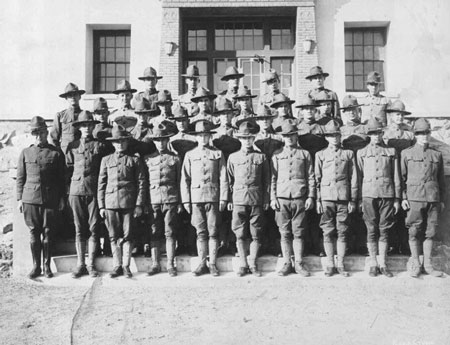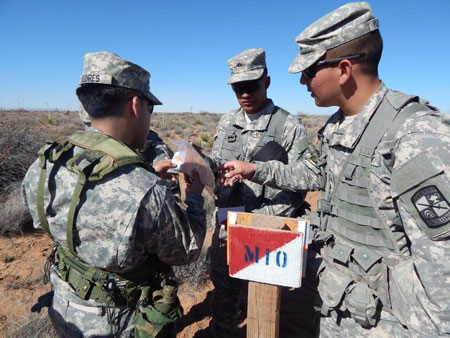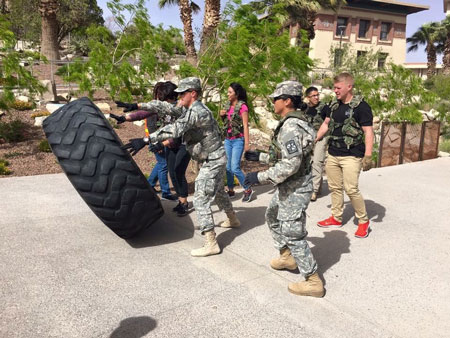Originally published Thursday, April 14, 2016
By Christina Rodriguez
UTEP Communications
The blazing sun beats down on their faces. Sweat streams down as they hunch low on the blistering desert sand. Together they trudge cautiously and quietly, navigating through the dry, rigid branches of dead brush as the wind stirs up an impetuous sandstorm around them. Their 35-pound backpacks weigh heavily on them as they creep closer to their objective.
They spot their target and a deafening silence falls over the area.

“Fire,” their leader shouts, followed by a storm of loud explosions. “Shift fire, lift fire!”
Once again there is silence as the troop briskly moves in to assess the aftermath of their accomplished mission.
This marks just another day of training for The University of Texas at El Paso’s ROTC cadets. UTEP’s ROTC is part of more than 600,000 officers, 275 programs and 1,000 campuses nationwide involved in Army ROTC.
Army ROTC has been developing leaders since 1916, and this year the program celebrates its centennial anniversary. Under the direction of the national Army ROTC, UTEP’s ROTC “Fighting Miner Battalion” program also stakes claim to a long, auspicious history and continues to build not only tenacious soldiers, but strong, dynamic leaders.
Before the ROTC program became official on the campus of the College of Mines and Metallurgy, ties between the college and the military were already strong. In 1914 the State School of Mines and Metallurgy was located adjacent to Fort Bliss on the property that formerly housed the El Paso Military Institute. Unfortunately, in 1916 an early morning fire broke out and completely destroyed the Main Building, resulting in the school’s relocation to its current campus.
In 1917 U.S. President Woodrow Wilson asked Congress for a declaration of war against Germany. By April 1917, the U.S. formally entered World War I, which created the need for military training of college students throughout the nation.
By August the School of Mines had put in a request to add an ROTC program. Instead of an ROTC program, the college received the Students’ Army Training Corps (SATC), where the War Department would pay the college to prepare students for the military. When the war ended in 1918, so did the SATC.
One early memorable leader who emerged from the School of Mines was Lt. James B. “Buster” Biggs. He was enrolled in the first cohort of 27 students admitted in 1914 and went on to become a World War I pilot who was killed in France in 1918 in the line of duty. Biggs Army Airfield was named in his honor in 1925.
In 1943, military training on the campus of the College of Mines and Metallurgy continued when 250 cadets of the national Army Specialized Training Program (ASTP) entered the college for training in engineering, science and humanities. Barrack buildings were moved onto the campus to house the cadets. They were under their own commandant and were under military discipline. The program was short lived and closed the following year when the trainees were integrated into the regular U.S. Army.

As Army ROTC was well underway in other universities and colleges around the nation, the College of Mines became part of the action on July 1, 1948 when the official Senior Army ROTC was established on the campus of the College of Mines and Metallurgy as an Artillery ROTC unit after college President Dossie Wiggins submitted a request to the Department of the Army in Washington D.C.
The new ROTC program on campus consisted of cadets who had no previous military training, cadets who had been members of ROTC in high school and returning veterans of World War II. The focus and dynamic of the early ROTC program was very different than the objectives of the program today.
Retired Maj. Gen. James Maloney was among the first cadets to take part in the ROTC program. He was pursuing his degree in civil engineering right out of high school in the early 1950s.
“Back then the ROTC program at Texas Western College was really only focused on anti-aircraft artillery, known now as air defense,” Maloney recalled. “It was 100 percent technical, commissioned in the branch of air defense artillery. It was all about being trained on guided missiles, cannons and radar.”
Maloney knew he wanted to be an Army officer by the age of 10. The ROTC program was able to help him develop the skills he needed to make his childhood dream a reality.
“Being a cadet in the ROTC program at Texas Western College, now UTEP, was the foundation of my military career,” he said. “Being a distinguished military student launched me into my 31-year-long Army career. This program was very important to me personally and professionally.”
Upon completion of his studies at Texas Western College, Maloney went on to serve as a major general in the Army and led Fort Bliss as commander from 1982-85.
In the 1950s, the Texas Western College ROTC program began a reciprocal program that invited the program’s cadets to Fort Bliss to see firsthand what the life of a soldier was like. The tradition lives on as cadets continue to spend time on base training in the field during their fall and spring training sessions.
Today, the ROTC program at UTEP has evolved not only in its use of modern day technology and advancements, but in its overall objective. Through the years, the focus has changed from air defense to military tactics to its present emphasis on leadership development.
“The overall objective of the program has evolved to … how effective the cadets are at leading and how they think through problems and use their assets to work through problems critically,” Lt. Col. James Lee, professor of military science, said. “This program teaches our cadets to lead in uncertainty and be able to lead in chaos.”
UTEP’s ROTC not only prepares its cadets for tactical defense, but to be good humanitarians as well.

“We instill in our cadets the ‘win without fighting’ approach by being globally engaged to improve people’s lives,” Lee said. “Being in the Army is not all about fighting, but how we can improve the economies, health and governance of other countries. You may be the first face someone sees of an American. You are not only a soldier but an ambassador.”
The emphasis on leadership and duty can be seen through the dedication and tenacity of current cadets in the program. Monday through Saturday, senior Grisel Davila wakes up at 4 a.m. and makes the drive from the Lower Valley to UTEP to participate in physical training by 6 a.m. In addition to being a cadet, she also manages her schoolwork as a full-time student, maintains a 3.8 GPA and works 40 hours a week to help support her grandmother, mother and sister.
“With the money I have saved up the past four years from working full-time and with support of the U.S. Army, I plan on attending law school when I graduate and becoming part of the prestigious Judge Advocate General’s Corps (JAG) in the military,” Davila said. “I cannot express my deepest gratitude to UTEP and the U.S. Army for helping to enhance my education and desire to become a leader and a professional.”
Junior Jordan Cedillo is a biological sciences major with a concentration in medical sciences. She hopes to pursue a career as a dentist in the Army, a career for which she feels her ROTC training has fully prepared her.
“ROTC is all about being the best leader that you can be,” Cedillo said confidently. “As a future dentist, I want to be able to create a positive environment for the people I work with as well as my patients. By being a cadet, I have gained pride, confidence and have made valuable connections that I can utilize in my future career.”
The ROTC program at UTEP not only prepares cadets to be successful soldiers ready for battle, but provides them with the foundations to develop versatile skills that will help them excel in any career path they choose to follow. Master Sgt. Anthony Dinkins, commandant of UTEP’s ROTC cadets, believes the cadets with whom he works on a daily basis have what it takes when they leave the program to become leaders in anything they pursue.
“UTEP’s ROTC is excellent in providing leader development in whatever field our cadets choose to take, not only benefiting themselves but the community as a whole by creating upward mobility,” Dinkins stated.
As Army ROTC celebrates its centennial anniversary, UTEP’s “Fighting Miner Battalion” will join in on the celebration to reflect on all the leaders the program has and continues to develop. A diverse group of men and women from all over the world owe their success and versatility to the program with roots that go back 100 years.
“What’s so great about UTEP’s ROTC program through Army ROTC is that it gives those students who want to get out and see the world the opportunity to do so when they otherwise might have not had the opportunity,” Dinkins said. “What’s so special about this program is that it gives those with tenacity the opportunity to lead and excel, no matter what profession they get into.”